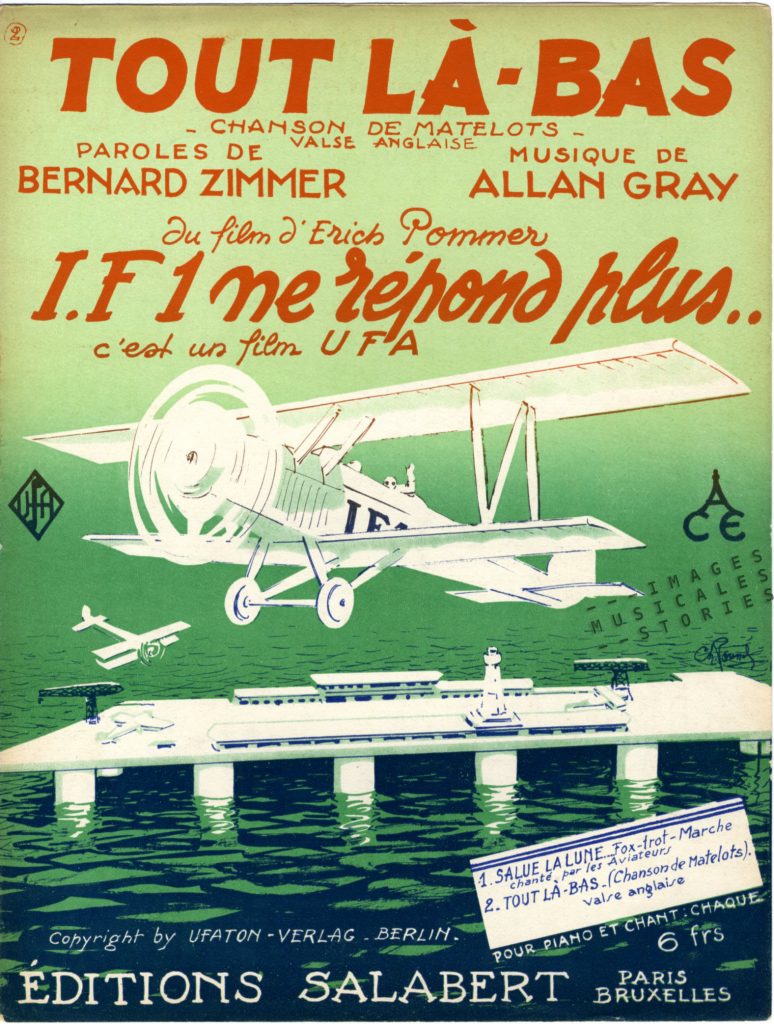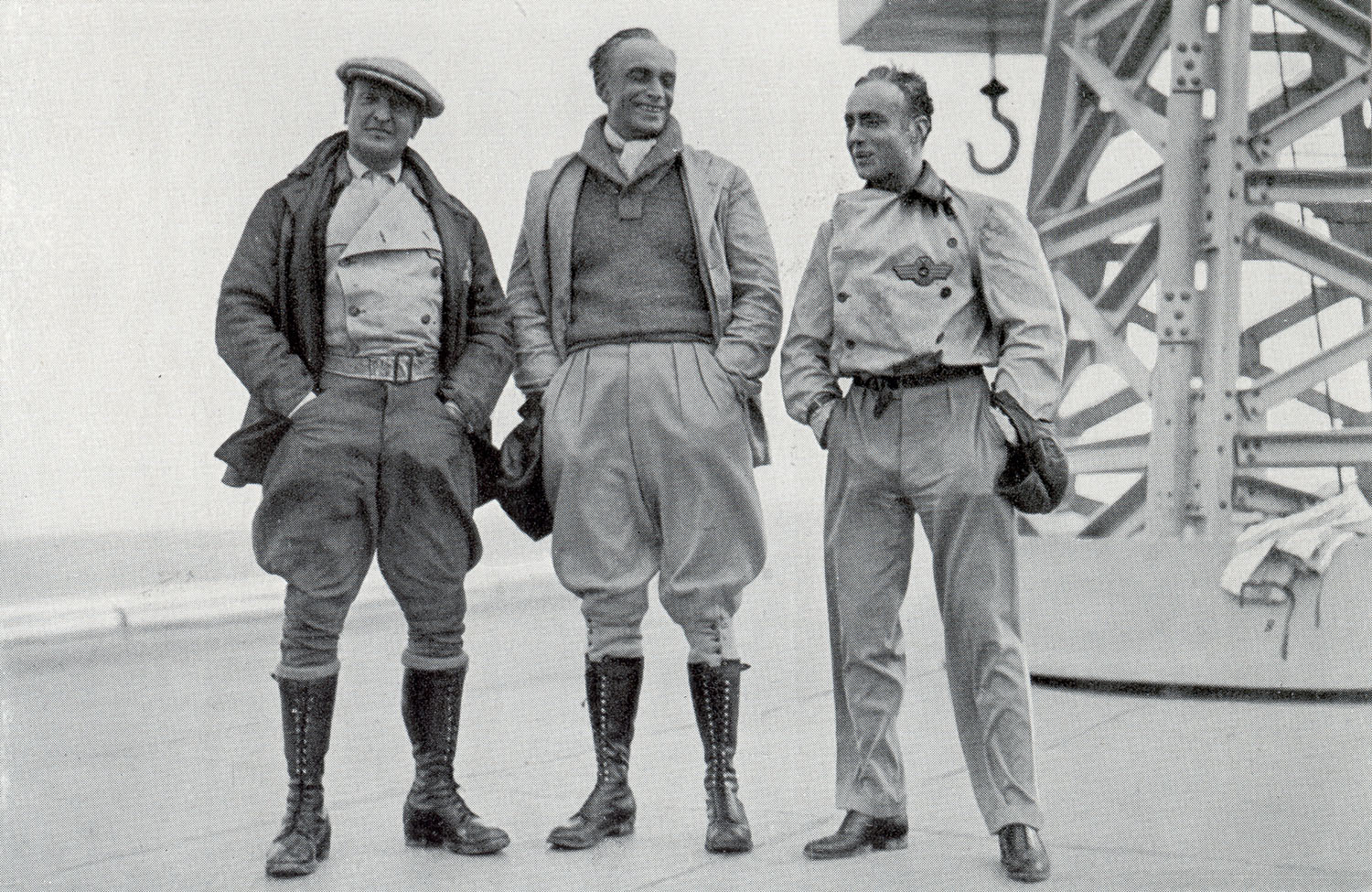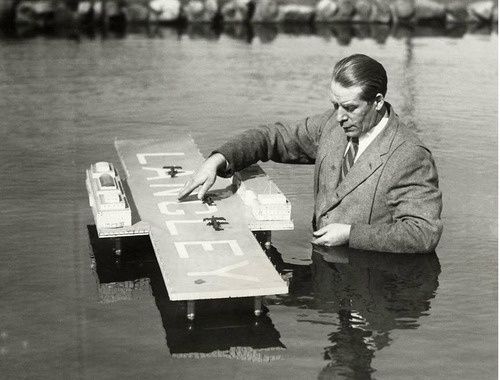
The sci-fi cover for the song Tout Là-bas – Chanson de Matelots shows air planes taking off from an artificial floating island. The song comes from the 1932 film I.F. 1 ne réponds plus. This was the French version of a German UFA production F.P.1 antwortet nicht, by Erich Pommer the producer of Metropolis and Der blaue Engel.
 During the early talkie period, before dubbing and subtitling became popular, films were produced in several languages for international markets, the so-called multiple-language version films. For F.P.1 antwortet nicht, the same plot, sets, crew and costumes were used to also make the French-spoken version and an English one, F.P.1 Doesn’t answer. Only the cast was changed.
During the early talkie period, before dubbing and subtitling became popular, films were produced in several languages for international markets, the so-called multiple-language version films. For F.P.1 antwortet nicht, the same plot, sets, crew and costumes were used to also make the French-spoken version and an English one, F.P.1 Doesn’t answer. Only the cast was changed.

The film F.P.1 antwortet nicht was based on a novel written by science fiction writer Kurt Siodmak published the previous year. The F.P.1 from the title stands for Floating Platform Number One.

Siodmak got his idea of a floating platform from the ‘seadromes’ invented by Edward R. Armstrong. This DuPont engineer had worked for years on a scheme for building a string of floating airports across the Atlantic. Air planes would then make stops at the various points where the seadromes were anchored.

In Popular Science from 1934 we find a clear description: it was Edward R. Armstrong’s plan to bridge the Atlantic with a string of artificial islands. Five of the seadromes would become anchored between America and Spain by way of the Azores. These would serve as refuelling stations each three hours of flight apart. Planes using these islands as steppingstones could thus transport heavier loads at greater speed since they carried less fuel. The platforms would have stabilizer legs to prevent the flight deck from pitching and rolling. Each seadrome would accommodate 100 travellers in addition to quarters for it’s own crew and hangars for 50 large planes. The seadrome would be run like a ship with a captain, officers, sailors, a physician and two meteorologists.

Edward R. Armstrong had already been designing and experimenting with sea bases for more than a decade, when in 1927 Charles Lindbergh succeeded to fly non-stop from New York to Paris. Within days songs were composed, and sheet music published, in order to pay tribute to Lindbergh’s Transatlantic Flight.

The most beautiful cover without doubt, was drawn by the Belgian illustrator Peter de Greef for the song De New York à Paris.

Lindbergh’s flight of the century encouraged Armstrong to further develop his idea to use the seadromes as floating airport platforms for refuelling during transatlantic flights. However the Great Depression crossed the plans to effectively install the seadromes. After World War II the ambitious project became obsolete altogether because of the use of long-range aircraft that did not need such refuelling points. Later though, the idea of an anchored deep-sea platform would be set to use for floating oil rigs.
But back to the film… Not a great plot: the classical love triangle and some sabotage aboard the F.P.1. It has Peter Lorre in a supporting role. If your secret pleasure is to listen to deep male voices singing in choir to the tune of a melancholic far-way-from-home accordion, then the Song of the Sailors from the sheet music cover at the top is worth your attention: fast forward to 51:20.

Foxtrot Lima, Foxtrot Lima,
this is Papa Delta
everything OK in South of Belgium
Kindly regards from tartaldjott & Co
Roger
out